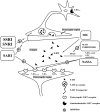Assessing the neuronal serotonergic target-based antidepressant stratagem: impact of in vivo interaction studies and knockout models
- PMID: 19506722
- PMCID: PMC2687932
- DOI: 10.2174/157015908785777256
Assessing the neuronal serotonergic target-based antidepressant stratagem: impact of in vivo interaction studies and knockout models
Abstract
Depression remains a challenge in the field of affective neuroscience, despite a steady research progress. Six out of nine basic antidepressant mechanisms rely on serotonin neurotransmitter system. Preclinical studies have demonstrated the significance of serotonin receptors (5-HT(1-3,6,7)), its signal transduction pathways and classical down stream targets (including neurotrophins, neurokinins, other peptides and their receptors) in antidepressant drug action. Serotonergic control of depression embraces the recent molecular requirements such as influence on proliferation, neurogenesis, plasticity, synaptic (re)modeling and transmission in the central nervous system. The present progress report analyses the credibility of each protein as therapeutically relevant target of depression. In vivo interaction studies and knockout models which identified these targets are foreseen to unearth new ligands and help them transform to drug candidates. The importance of the antidepressant assay selection at the preclinical level using salient animal models/assay systems is discussed. Such test batteries would definitely provide antidepressants with faster onset, efficacy in resistant (and co-morbid) types and with least adverse effects. Apart from the selective ligands, only those molecules which bring an overall harmony, by virtue of their affinities to various receptor subtypes, could qualify as effective antidepressants. Synchronised modulation of various serotonergic sub-pathways is the basis for a unique and balanced antidepressant profile, as that of fluoxetine (most exploited antidepressant) and such a profile may be considered as a template for the upcoming antidepressants. In conclusion, 5-HT based multi-targeted antidepressant drug discovery supported by in vivo interaction studies and knockout models is advocated as a strategy to provide classic molecules for clinical trials.
Keywords: Serotonin; depression; interaction studies; knockout models; preclinical screening; target.; trophic factors.
Figures


Similar articles
-
Behavioral and serotonergic consequences of decreasing or increasing hippocampus brain-derived neurotrophic factor protein levels in mice.Neuropharmacology. 2008 Nov;55(6):1006-14. doi: 10.1016/j.neuropharm.2008.08.001. Epub 2008 Aug 12. Neuropharmacology. 2008. PMID: 18761360 Review.
-
Ketamine treatment involves medial prefrontal cortex serotonin to induce a rapid antidepressant-like activity in BALB/cJ mice.Neuropharmacology. 2017 Jan;112(Pt A):198-209. doi: 10.1016/j.neuropharm.2016.05.010. Epub 2016 May 17. Neuropharmacology. 2017. PMID: 27211253
-
Potential involvement of serotonergic signaling in ketamine's antidepressant actions: A critical review.Prog Neuropsychopharmacol Biol Psychiatry. 2016 Nov 3;71:27-38. doi: 10.1016/j.pnpbp.2016.05.007. Epub 2016 Jun 2. Prog Neuropsychopharmacol Biol Psychiatry. 2016. PMID: 27262695 Review.
-
Reversal of hippocampal neuronal maturation by serotonergic antidepressants.Proc Natl Acad Sci U S A. 2010 May 4;107(18):8434-9. doi: 10.1073/pnas.0912690107. Epub 2010 Apr 19. Proc Natl Acad Sci U S A. 2010. PMID: 20404165 Free PMC article.
-
Mirtazapine : A Review of its Pharmacology and Therapeutic Potential in the Management of Major Depression.CNS Drugs. 1996 May;5(5):389-402. doi: 10.2165/00023210-199605050-00007. CNS Drugs. 1996. PMID: 26071050
Cited by
-
Novel 5-HT3 receptor antagonist QCM-4 attenuates depressive-like phenotype associated with obesity in high-fat-diet-fed mice.Psychopharmacology (Berl). 2017 Apr;234(7):1165-1179. doi: 10.1007/s00213-017-4558-0. Epub 2017 Feb 25. Psychopharmacology (Berl). 2017. PMID: 28238069
-
Pharmacological evaluation of novel 5-HT3 receptor antagonist, QCM-13 (N-cyclohexyl-3-methoxyquinoxalin-2-carboxamide) as anti-anxiety agent in behavioral test battery.J Pharm Bioallied Sci. 2015 Apr-Jun;7(2):103-8. doi: 10.4103/0975-7406.154429. J Pharm Bioallied Sci. 2015. PMID: 25883513 Free PMC article.
-
Role of Hypothalamic-pituitary-adrenal-axis in Affective Disorders: Anti-depressant and Anxiolytic Activity of Partial 5-HT1A Agonist in Adrenalectomised Rats.Indian J Psychol Med. 2013 Jul;35(3):290-8. doi: 10.4103/0253-7176.119501. Indian J Psychol Med. 2013. PMID: 24249933 Free PMC article.
References
-
- Abumaria N, Rygula R, Hiemke C, Fuchs E, Havemann-Reinecke U, Ruther E, Flugge G. Effect of chronic citalopram on serotonin-related and stress-regulated genes in the dorsal raphe nucleus of the rat. Eur. Neuropsychopharmacol. 2007;17:417–429. - PubMed
-
- Adell A. Antidepressant properties of substance P antagonists: relationship to monoaminergic mechanisms? Curr. Drug Targets CNS Neurol. Disord. 2004;3:113–121. - PubMed
-
- Adell A, Castro A, Celada P, Bortolozzi A, Pazos A, Artigas F. Strategies for producing faster acting antidepressants. Drug Discov. Today. 2005;10:578–585. - PubMed
-
- Altar CA. Neurotrophins and depression. Trends Pharmacol. Sci. 1999;20:59–61. - PubMed
LinkOut - more resources
Full Text Sources
